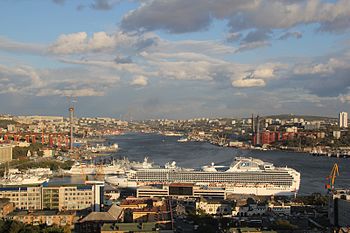 SANTIAGO CITY is the first component- independent city in the Cagayan Valley Region. Historically, the city was called “El Pueblo de Carig” by the Spanish Dominican Friars who started colonizing and christianizing the natives of the pueblo in 1597.
SANTIAGO CITY is the first component- independent city in the Cagayan Valley Region. Historically, the city was called “El Pueblo de Carig” by the Spanish Dominican Friars who started colonizing and christianizing the natives of the pueblo in 1597.The City of Santiago is a 1st class city in the province of Isabela, Philippines. According to the latest census, it has a population of 126,244 people in 22,401 households. Santiago is situated 79 kilometers south of Ilagan, the provincial capital, and about 326 kilometers North of Metro Manila. The city sits on a vast area of predominantly flat and fertile land in the Cagayan Valley, surrounded by the Caraballo Mountains to the south, the Great Sierra Madre to the east and the Cordillera Mountain Range to the west.
The earliest reference to the existence of Santiago de Carig was contained in the documents found in the Dominican Archives of the University of Sto. Tomas that mentioned the Iyogads as contemporaries of Santiago de Carig’s early population which consisted mainly of Ibanags and Gaddangs.
It was formerly a barrio of Echague. The towns Cordon, Diffun, Saguday, San Mateo and Ramon were formerly its barrios.

The first five barrios after the Cadastral survey in 1927 were Patul, Batal, Nabbuan, Buenavista and Dubinan.
The area bounded by the Provincial road on the NW Carreon St on the SW Abauag St on the NE and the lot of the Methodist on the SE was the site of the first public school building before it became a market site.
Another favorable point confirming the existence of Santiago de Carig before 1743 was the DECREE of request issued on October 30, 1713 which required the inhabitants of Carig, together with those of Cordon, Diffun and Sta. Barbara de Lappao to give rice and money to the missionaries of the Holy Rosary in the province run by the Sacred Order of Preachers with headquarters in Ituy and Paniqui.
The term Pueblo ascribed to Santiago de Carig in the foregoing statement refers to the pre 1743 status as a mission pueblo and not as a Spanish name of “Santiago de Carig” in honor of St. James the Apostle whose feast day is celebrated July 25, back in 1743 and most probably earlier than that.
Further, historical records show that the Municipality of Santiago was officially created by Royal Decree on May 1743.
Santiago became the first city in the region through the enactment of RA No. 7720 on May 5, 1994 converting the then municipality of Santiago into independent-component city. Considered as the “Trade and Commercial Center of Cagayan Valley Region”, its strategic location makes it an important destination for businessmen or would-be investors and tourists.
Santiago City is 328 kilometers from Metro Manila and is accessible by land from any point in Luzon. The city is strategically located and considered a melting pot, all roads in the four provinces of Cagayan Valley Region lead to and out of it. And the influx of people and goods make the city the center of trade and commerce in the region.
Year 2000 census showed that Santiago City had a population of 110,531, half of which are living in the urban areas. The city has an annual growth rate of 2.5 percent. The city covers an area of 255 square kilometers with 37 barangays.
OFFICIAL DETAILS:
City Head:
City Population:
City Land Area:
City Classification:
AWARDS & CITATIONS:
MONIKER/NICKNAMES:
LINKS FOR MORE ABOUT THE CITY HERE:
MORE OF THE CITY’S PIC HERE:
 SANTIAGO CITY is the first component- independent city in the Cagayan Valley Region. Historically, the city was called “El Pueblo de Carig” by the Spanish Dominican Friars who started colonizing and christianizing the natives of the pueblo in 1597.
SANTIAGO CITY is the first component- independent city in the Cagayan Valley Region. Historically, the city was called “El Pueblo de Carig” by the Spanish Dominican Friars who started colonizing and christianizing the natives of the pueblo in 1597.



















